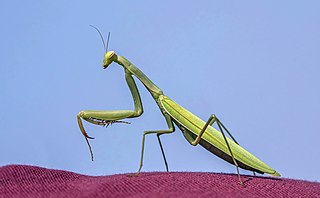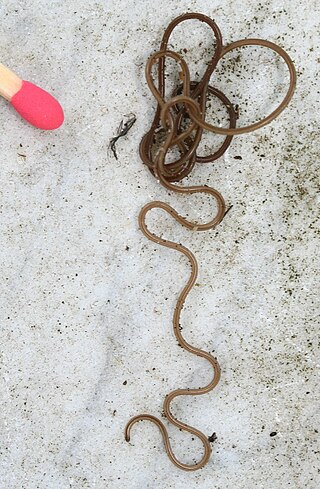
Nematomorpha are a phylum of parasitoid animals superficially similar to nematode worms in morphology, hence the name. Most species range in size from 50 to 100 millimetres, reaching 2 metres (79 in) in extreme cases, and 1 to 3 millimetres in diameter. Horsehair worms can be discovered in damp areas, such as watering troughs, swimming pools, streams, puddles, and cisterns. The adult worms are free-living, but the larvae are parasitic on arthropods, such as beetles, cockroaches, mantises, orthopterans, and crustaceans. About 351 freshwater species are known and a conservative estimate suggests that there may be about 2000 freshwater species worldwide. The name "Gordian" stems from the legendary Gordian knot. This relates to the fact that nematomorphs often coil themselves in tight balls that resemble knots.
Hymenolepiasis is infestation by one of two species of tapeworm: Hymenolepis nana or H. diminuta. Alternative names are dwarf tapeworm infection and rat tapeworm infection. The disease is a type of helminthiasis which is classified as a neglected tropical disease.

The Mormon cricket is a large insect native to western North America in rangelands dominated by sagebrush and forbs. Anabrus is a genus in the shield-backed katydid subfamily in the Tettigoniidae family, commonly called katydids, bush crickets, and previously "long-horned grasshoppers". Its common name, "Mormon cricket", is a misnomer: true crickets are of the family Gryllidae.
Schistosoma japonicum is an important parasite and one of the major infectious agents of schistosomiasis. This parasite has a very wide host range, infecting at least 31 species of wild mammals, including nine carnivores, 16 rodents, one primate (human), two insectivores and three artiodactyls and therefore it can be considered a true zoonosis. Travelers should be well-aware of where this parasite might be a problem and how to prevent the infection. S. japonicum occurs in the Far East, such as China, the Philippines, Indonesia and Southeast Asia.

Spinochordodes tellinii is a parasitic nematomorph hairworm whose larvae develop in grasshoppers and crickets. This parasite is able to influence its host's behavior: once the parasite is grown, it causes its grasshopper host to jump into water, where the grasshopper will likely drown. The parasite then leaves its host; the adult worm lives and reproduces in water. S. tellinii does not influence its host to actively seek water over large distances, but only when it is already close to water.

Meconema thalassinum is an insect in the family Tettigoniidae known as the oak bush-cricket and drumming katydid. It is native to Europe, including the British Isles, and was introduced to the United States, first established in the west of Long Island and extending its range to Rhode Island and Scarsdale, Stony Brook, and Ithaca, New York.

Orthodera ministralis, common name garden mantis or Australian green mantis, is a species of praying mantis from Australia.

Empusa pennata, or the conehead mantis, is a species of praying mantis in genus Empusa native to the Mediterranean Region. It can be found in Portugal, Spain, southern France, Italy and on the mediterranean coasts of Morocco, Algeria, Tunisia, Libya, Turkey and Egypt. Because of its cryptic nature, or also possibly because of its fragmented, low-density populations, it is rarely encountered in the wild.

Paragordius tricuspidatus belongs to the phylum Nematomorpha, and is known for manipulating the behavior of its host, the cricket Nemobius sylvestris. In its larval stage, the worm is microscopic, but grows into a large worm inside its host after accidental ingestion since their eggs are laid at the edge of the water by rivers where crickets frequently reside. Upon ingestion, the worm nourishes upon its host and fills the entire body cavity of the cricket, until maturation, when the parasitic worm is ready to exit into water to complete its life cycle, maximizing its reproductive success. The worm induces a peculiar behavior in its cricket host which causes the cricket to leap into water whereby the parasitic worm can slither out and find its mate, while the cricket often perishes. Should the cricket be preyed upon by a predator, such as a fish or frog, the worm has the ability to not only escape from the host's body but also the predator's digestive system. The worm emerges from the predator unharmed and proceeds to live its life normally.

Mantises are an order (Mantodea) of insects that contains over 2,400 species in about 460 genera in 33 families. The largest family is the Mantidae ("mantids"). Mantises are distributed worldwide in temperate and tropical habitats. They have triangular heads with bulging eyes supported on flexible necks. Their elongated bodies may or may not have wings, but all Mantodea have forelegs that are greatly enlarged and adapted for catching and gripping prey; their upright posture, while remaining stationary with forearms folded, has led to the common name praying mantis.
Pinnixa chaetopterana, the tube pea crab, is a small decapod crustacean that lives harmlessly within the tube of the polychaete worm, Chaetopterus variopedatus.
Paragordius varius is a parasite species in the horsehair worm group (Nematomorpha). They cycle between terrestrial and aquatic habitats and are most commonly known for their ability to manipulate their definitive host to jump into a pool of water, which allows them to complete their life cycle. Adults are over 10 cm long and 400 μm in diameter. P. varius is usually found in water or wet areas. The definitive hosts are mainly terrestrial arthropods, most often carabid beetles, crickets and praying mantids.

Chordodes formosanus is a horsehair worm that has the praying mantis as its definitive host. Horsehair worms are obligate parasites that pass through different hosts at various stages. These worms can grow up to 90 cm long and can be extremely dangerous for their host, especially the praying mantis.

Caedicia simplex is a species of bush cricket or katydid, native to New Zealand and Australia. A common name is the "common garden katydid".
Nectonema is a genus of marine horsehair worms first described by Addison E. Verrill in 1879. It is the only genus in the family Nectonematidae described by Henry B. Ward in 1892, in the order Nectonematoidea, and in the class Nectonematoida. The genus contains five species; all species have a parasitic larval stage inhabiting crustacean hosts and a free-living adult stage that swims in open water.

Gordiidae is a family of parasitic horsehair worms belonging to the order Gordioidea.
Parachordodes is a genus of worms belonging to the family Chordodidae.

Paragordius is a genus of worms belonging to the family Chordodidae. It was independently described by both Lorenzo Camerano in 1897 and Thomas Harrison Montgomery Jr. in 1898, though both authors gave the genus the same name.
Gordius balticus is a species of horsehair worm belonging to the genus Gordius.
Podagrion mantis was first described in 1886 by W.H. Ashmead, and was the first species of its genus to have been described from the United States. All species in the genus are parasitoid wasps known only to parasitize mantids. They have been observed most often utilizing the egg case (ootheca) of Stagmomantis carolina, but have also been reported to choose S.limbata or Tenodera augustipennis as hosts, showing a high degree of specialization.











